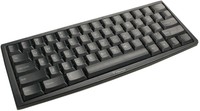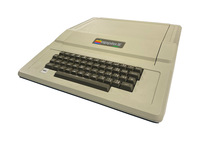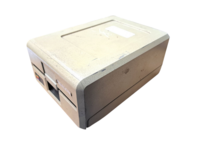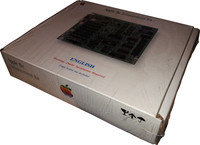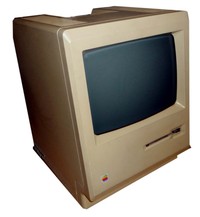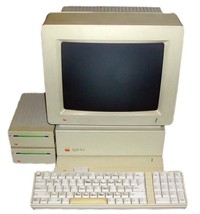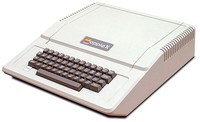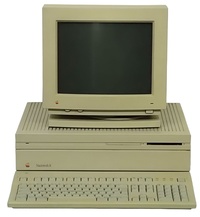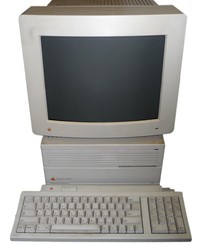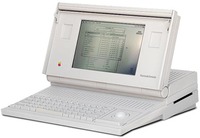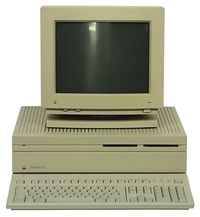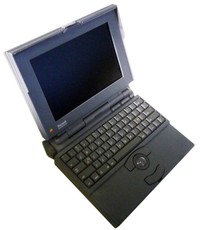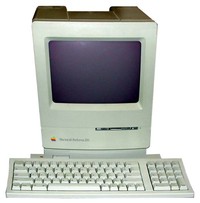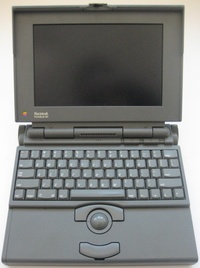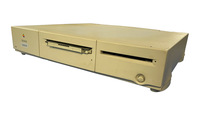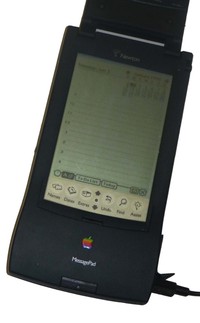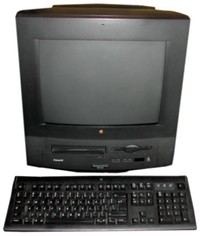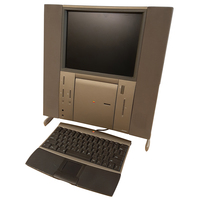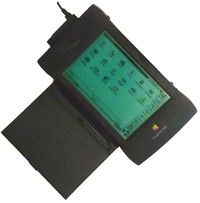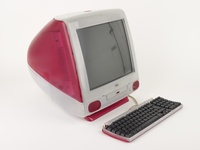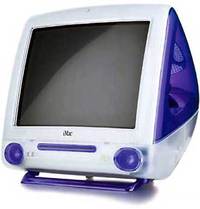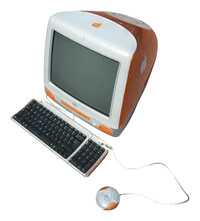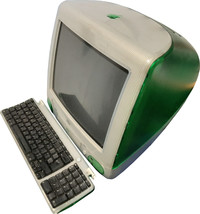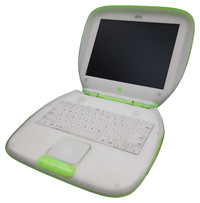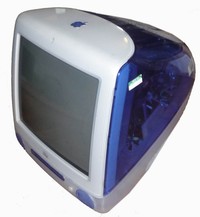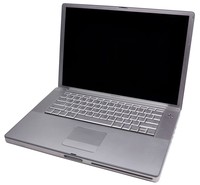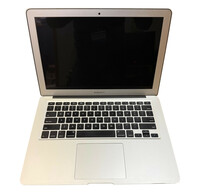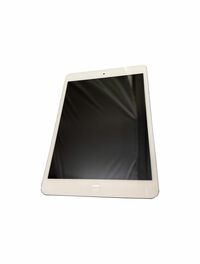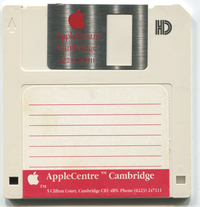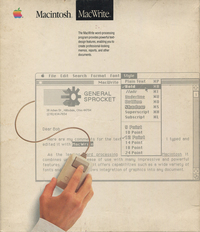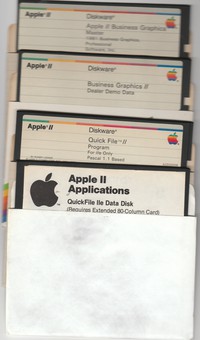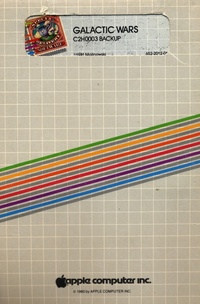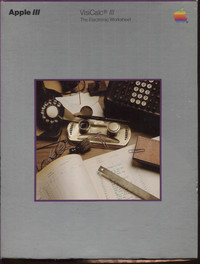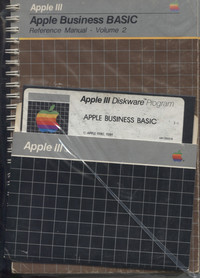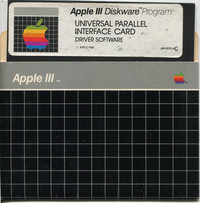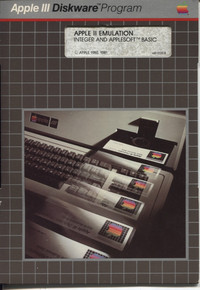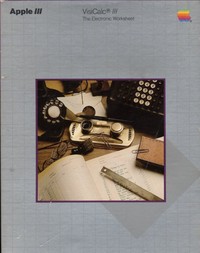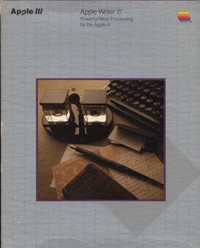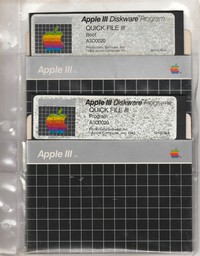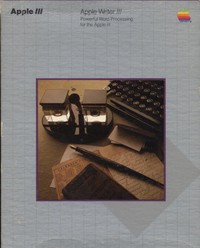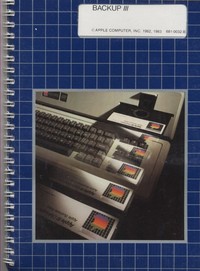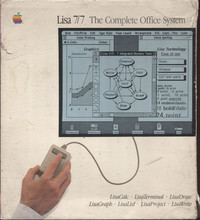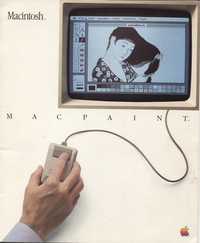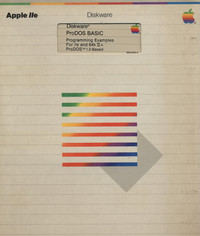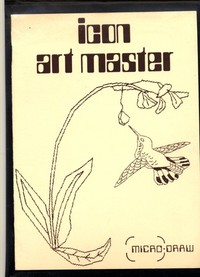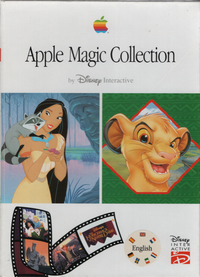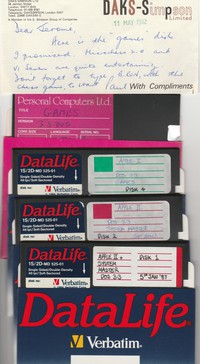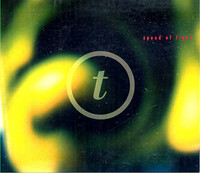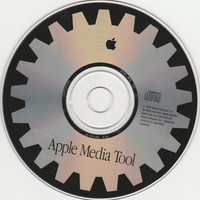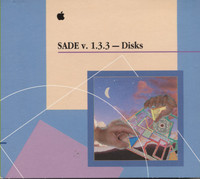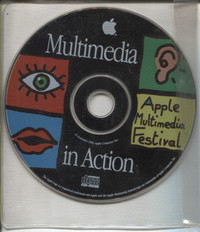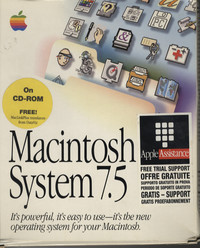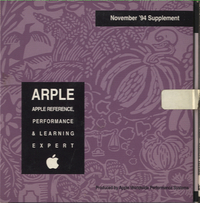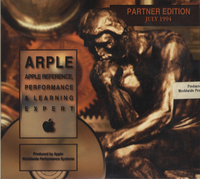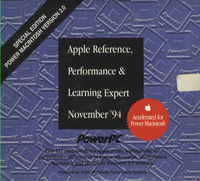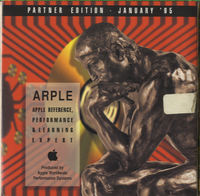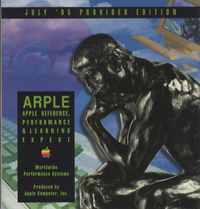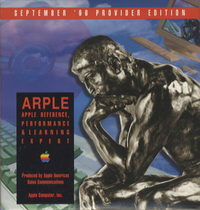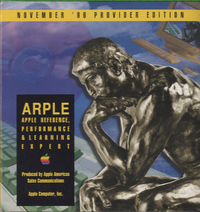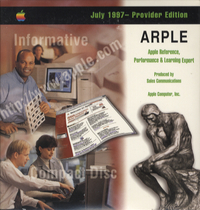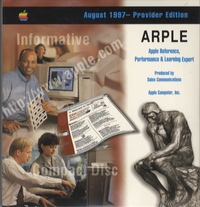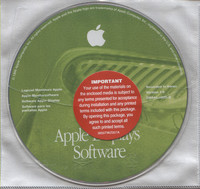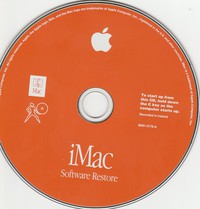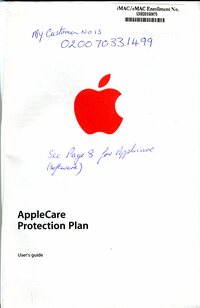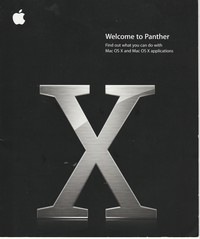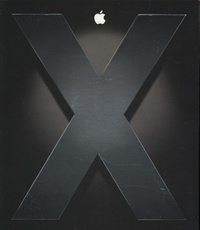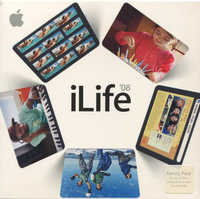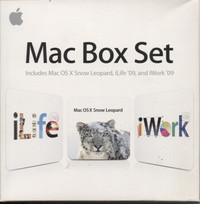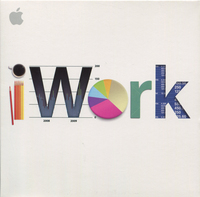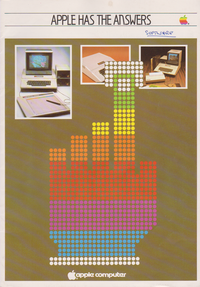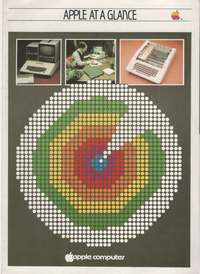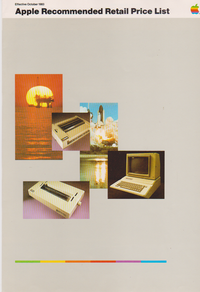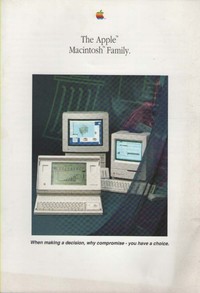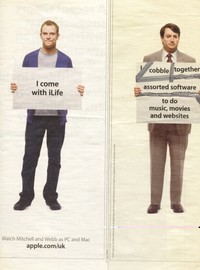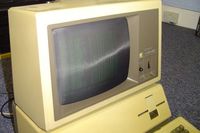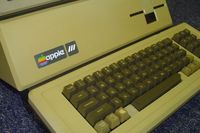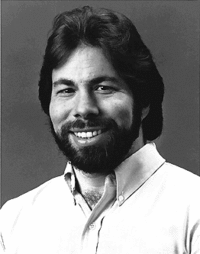Apple Computer Inc. was founded by Steve Wozniak, Steve Jobs and Ronald Wayne on the 1st April 1976. Ronald Wayne soon sold his stock to Jobs and Wozniak, but the success of the Apple 1 inspired them to go on and develop the hugely successful Apple II.
From 1976 until today, Apple has had three name variations: Apple Computer Company (1976-1977) Apple Computer Inc. (1977-2007), and Apple Inc. (2007-present). We typically refer to the company as Apple.
The Apple 1 went on sale in July 1976 as an assembled circuit board. They produced just 200 of their Apple 1 computer which was extremely well received, even though it was simply a circuit board to which the owner had to add a keyboard and monitor. It had a retail price of $666.66. We are very lucky to have a replica of this computer in our museum. The operating system was a simple System Monitor. It had a BASIC Interpreter written by Steve Wozniak called Integer BASIC.
The Apple II (sometimes styled as Apple ][) was a series of computers as detailed below which used an operating system.
The Apple III (sometimes styled as Apple ///) is a business-oriented personal computer released in 1980. Running the Apple SOS (Sophisticated Operating System), it was intended as the successor to the Apple II, but was largely considered a failure in the market. It was designed to provide key features business users wanted in a personal computer: a true typewriter-style upper/lowercase keyboard (the Apple II only supported uppercase) and an 80-column display. We also hold an Apple III Plus in our collection.
In 1983, Apple released the Apple Lisa, a desktop computer. It had a graphical user interface (GUI) targeted at individual business users. Development began in 1978. It had a 5MB hard drive. Lisa was affected by its high price, insufficient software, unreliable Apple FileWare disks, and the immediate release of the cheaper and faster Apple Macintosh. Only 10,000 Apple Lisas were sold in two years.
Apple Macintosh XL was a modified version of the Apple Lisa personal computer made by Apple Computer, Inc. In the Macintosh XL configuration, the computer shipped with MacWorks XL, a Lisa program that allowed 64 K Macintosh ROM emulation.
The Lisa came with a bundle of seven software applications, running on top of a modified Apple SOS with a GUI called the Lisa Office System, an operating system that featured protected memory and pre-emptive multitasking. The seven software applications included were LisaWrite (word processing), LisaCalc (spreadsheet), LisaDraw (vector graphics), LisaGraph (graphing), LisaProject (project management), LisaList (to-do lists), and LisaTerminal (terminal emulator for network communications).
Conceptually, the Lisa resembled the Xerox Star in the sense that it was envisioned as an office computing system. Lisa has two main user modes: the Lisa Office System and the Workshop. The Lisa Office System is the GUI environment. The Lisa Office System was eventually renamed "7/7", in reference to the seven supplied application programs: LisaWrite, LisaCalc, LisaDraw, LisaGraph, LisaProject, LisaList, and LisaTerminal.
The Workshop is a program development environment and is almost entirely text-based, though it uses a GUI text editor. It could be run to develop Lisa software, and later was used to develop the Macintosh System and early Macintosh software. Around 1986, the Lisa Workshop was replaced with the Macintosh Programmer's Workshop which ran inside the Macintosh operating system.
Starting in 1984, Apple also sold the MacWorks Macintosh virtualization environment, which allowed Lisa computers to run Macintosh software. MacWorks 1.0 ran System Software 0.1, MacWorks 2.0 ran System Software 0.3 and 0.5, and MacWorks 3.0 ran System Software 0.5.
The original Macintosh 128K came in a beige case containing a 9 in (23 cm) CRT monitor and came with a keyboard and mouse. It played a pivotal role in establishing desktop publishing. It was shipped with the very first System and Finder application, known to the public as "System 1.0" (formally known as System 0.97 and Finder 1.0). The applications MacPaint and MacWrite were bundled with the Mac. Other programs available included MacProject, MacTerminal and Microsoft Word. Programming languages available at the time included MacBASIC, MacPascal and the Macintosh 68000 Development System.
The Macintosh SE/30 had a black-and-white monitor and could be expanded up to 128 MB of RAM (a significant amount of RAM at the time), and included a 40 or 80 MB hard drive. It was also the first compact Mac to include a 1.44 MB high density floppy disk drive as standard. The power of the SE/30 was demonstrated by its use to produce the This Week newspaper, the first colour tabloid newspaper in the UK to use new, digital pre-press technology on a personal, desktop computer. "SE" is an initialism for "System Expansion". Apple had been naming all computers using the 68030 processers with an "x", such as the IIx and IIcx. When it came time to put the 68030 processor into the SE series, they prudently decided that calling it the Macintosh "SEx" wasn't the best marketing idea, so they settled on "SE 30".
The Macintosh Color Classic (sold as the Macintosh Colour Classic in PAL regions and Macintosh Color Deluxe in Japan) is a personal computer sold from February 1993 to May 1995 (up to January 1998 in PAL markets). It has an "all-in-one PC" design, based on a Motorola 68030 CPU running at 16 MHz with a small, integrated 10″ Sony Trinitron display at 512 × 384 pixel resolution. The display is capable of supporting up to thousands of colours with a video memory upgrade.
The Apple Macintosh II sold from March 1987 to January 1992 was based on the Motorola 68020 32-bit CPU, it was the first Macintosh supporting colour graphics., its pricing meant it competed with workstations from Silicon Graphics, Sun Microsystems, and Hewlett-Packard.
The Macintosh II was updated with a more powerful CPU and sold as the Macintosh IIx. In early 1989, the more compact Macintosh IIcx was introduced at a price similar to the original Macintosh II, and by the beginning of 1990 sales stopped altogether. Motherboard upgrades that could turn a Macintosh II into a IIx or Macintosh IIfx were offered by Apple.
Next was the Macintosh LC family, with LC standing for “Low Cost”. They were also known as “Elsie”. It was introduced at half the price of the Macintosh II but was significantly lesser in performance overall, so that could be sold to schools for the same price as an Apple IIGS. It was introduced in October 1990, then subsequently replaced by Macintosh LC II, which was largely the same but was built around a Motorola 68030 processor.
The Performa line of Macintoshes re-used models from Apple's Quadra, Centris, LC, and Power Macintosh families, with model numbers that denoted the included software packages or hard drive sizes. Whereas non-Performa Macintosh computers were sold by Apple Authorized Resellers, the Performa was sold in the USA through big-box stores and mass-market retailers such as Good Guys, Circuit City, and Sears and in Europe through department stores and mass-market retailers.
The initial series consisted of the Macintosh Classic II-based Performa 200, the LC II-based Performa 400, and the IIvi-based Performa 600. Unlike the professional Macintosh computers, each individual Performa bundle was given a unique model number, in some cases varying only by the software bundle or the specific retailer that sold that model. This was intended to accommodate retailers, who could advertise that they could beat their competitors' price on equivalent models while at the same time ensuring that they did not actually carry the same models as their competitors. To help personal users choose between the options available to them, Apple created multiple paid advertisements.
After releasing around sixty-four different models, Apple retired the Performa brand in early 1997, shortly after release of the Power Macintosh 5500, 6500, 8600 and 9600, as well as the return of Steve Jobs to the company. The Performa brand's lifespan coincided with a period of significant financial turmoil at Apple due in part to the proliferation of different models and low sales of Performa machines.
The Macintosh Portable sold from September 1989 to October 1991 and was the first battery-powered Macintosh. It featured a fast, sharp, and expensive black-and-white active matrix LCD screen in a hinged design that covered the keyboard when the machine was not in use. The Portable was one of the early consumer laptops to employ an active matrix panel - only the most expensive of the initial PowerBook line, the PowerBook 170, had such a panel. The machine was designed to deliver high performance, at the cost of increased price and weight.
The Macintosh Centris family came along as a replacement for the six-year-old Macintosh II family of computers. The name was chosen to indicate that the consumer was selecting a Macintosh in the center of Apple's product line. Centris machines were the first to offer Motorola 68040 CPUs at a price point making them significantly less expensive (albeit slower) than Macintosh Quadra computers, but also offering higher performance than the Macintosh LC computers of the time.
The Macintosh Quadra family sold from October 1991 to October 1995. The Quadra, named after the Motorola 68040 central processing unit, replaced the Macintosh II family as the high-end Macintoshes.
The first models were the Quadra 700 and Quadra 900, both introduced in October 1991. The Quadra 800, 840AV and 605 were added through 1993. The Macintosh Centris line was merged with the Quadra in October 1993, adding the 610, 650 and 660AV to the range. After the introduction of the Power Macintosh line in early 1994, Apple continued to produce and sell new Quadra models; the 950 continued to be sold until October, 1995.
Timeline for Apple :
| 24 Feb 1955 |
Steve Jobs, co-founder of Apple, is born
|
| 1964 |
Douglas Engelbart invents the mouse
|
| 1 Mar 1973 |
Xerox Alto personal computer is developed at Xerox PARC
|
| 1974 |
Steve Jobs gains employment at Atari
|
| 1 Apr 1976 |
Steve Wozniak, Steve Jobs, and Ronald Wayne found Apple Computer Inc.
|
| Jul 1976 |
Apple launches the Apple 1
|
| 10 Jun 1977 |
Apple releases the Apple II
|
| 3 Aug 1977 |
Tandy announces the TRS-80 computer
|
| 5 Dec 1978 |
Acorn Computers Ltd founded in Cambridge, UK
|
| 11 May 1979 |
VisiCalc publicly demonstrated for the first time
|
| Jun 1979 |
Apple releases the Apple II+
|
| 17 Oct 1979 |
Personal Software releases VisiCalc, the first spreadsheet
|
| Apr 1980 |
News Article : Keen attack on small-scale user market
|
| May 1980 |
News Article : PO approval for Apple
|
| 19 May 1980 |
Apple announces the Apple III
|
| Jun 1980 |
News Article : Schools given Apples worth £30,000
|
| Jun 1980 |
News Article : Best-selling software
|
| Jun 1980 |
News Article : Software company based on years of study
|
| Jul 1980 |
News Article : Apple aims for Cork
|
| Jul 1980 |
News Article : NCC Anaheim report
|
| Dec 1980 |
News Article : Accurate high-speed drawing with latest package for Apple II
|
| 12 Dec 1980 |
Apple floats on the stock market
|
| Jan 1981 |
News Article : News of Cobol and Coral 66
|
| Jan 1981 |
News Article : Megastore 8in. drive
|
| Jan 1981 |
News Article : Versawriter makes full use of Apple graphics facility
|
| Jan 1981 |
News Article : Apple II digital synthesiser can mimic musical instruments
|
| Feb 1981 |
News Article : Secret settlement in Apple and ITT copyright case
|
| Feb 1981 |
News Article : Wide range of applications open to Apple bar-code reader
|
| Apr 1981 |
News Article : Tipping the scales in favour of accurate weight records
|
| Apr 1981 |
News Article : Homeline cuts costs in property market
|
| May 1981 |
News Article : How you and your machine can make beautiful music
|
| May 1981 |
News Article : Apple sees to the lighting
|
| May 1981 |
News Article : Microsense is bought
|
| Jun 1981 |
News Article : ApplePilot is latest instruction language
|
| Jul 1981 |
News Article : Extra products to suit Apple
|
| 12 Aug 1981 |
IBM announces the IBM 5150, the first IBM PC
|
| Sep 1981 |
News Article : The British answer to imported best-sellers
|
| Sep 1981 |
News Article : Apple helps chemists swallow stock control's bitter pill
|
| Oct 1981 |
News Article : More Apple peripherals
|
| Oct 1981 |
News Article : Tangerine soups up Tantel as its rival hits the shops
|
| Oct 1981 |
News Article : Pet system is a real gem
|
| Nov 1981 |
News Article : Criticism for package that copies protected software
|
| Nov 1981 |
News Article : Apple takes control with IEEE-488 card
|
| Nov 1981 |
News Article : First UK export for States-side Apples
|
| Dec 1981 |
News Article : Lid's role in great Apple cover-up
|
| Jan 1982 |
News Article : Business Apple III sheds hobbyist image
|
| Jan 1982 |
News Article : Electronic change for budding Beethovens
|
| Jan 1982 |
News Article : Programmer's Apple boon
|
| Feb 1982 |
News Article : Five boards that add to Apple's attractions
|
| Feb 1982 |
News Article : Printed word said to improve with Ap Pak
|
| Mar 1982 |
News Article : The Welsh connection
|
| Mar 1982 |
News Article : Free Apple II brochures
|
| Apr 1982 |
News Article : Universal appeal of CBM's new micros
|
| Apr 1982 |
News Article : ITT 3030 puts the accent on expansion
|
| May 1982 |
News Article : Making light of airfreight
|
| May 1982 |
News Article : U-A/D is complete Apple interface pack
|
| Jun 1982 |
News Article : Another three for Apple III
|
| Jul 1982 |
News Article : Cartridge memory
|
| Jul 1982 |
News Article : Software hiring scheme
|
| Aug 1982 |
News Article : Zap into music
|
| Sep 1982 |
News Article : A taste of Apple IV?
|
| Oct 1982 |
News Article : Wider choice for Sirius
|
| Nov 1982 |
News Article : Checkmate to Boss
|
| Nov 1982 |
News Article : Eyes for the micro
|
| Nov 1982 |
News Article : Fast 256K pseudo-disc
|
| Nov 1982 |
News Article : New products in brief
|
| Dec 1982 |
News Article : Plug-in card gives Apple 16-bit power
|
| Dec 1982 |
News Article : Full accounts package runs on Apple II
|
| Jan 1983 |
News Article : Apple memory
|
| 19 Jan 1983 |
Apple launches the Apple Lisa
|
| 27 Jan 1983 |
News Article : New Apple micro as IBM gets UK debut
|
| Mar 1983 |
News Article : New lease of life for Apple II
|
| Mar 1983 |
News Article : Apple, DEC and IBM set to compete for executive market
|
| Apr 1983 |
News Article : Best-selling database manager for PC
|
| Apr 1983 |
Steve Jobs hires Pepsi's John Sculley as President of Apple
|
| May 1983 |
News Article : Program copier to Apple discs
|
| May 1983 |
News Article : Better database
|
| May 1983 |
News Article : Apple II pared to its core
|
| May 1983 |
News Article : VisiCalc and Co now on PC
|
| May 1983 |
News Article : All-in-one Lotus
|
| 11 Aug 1983 |
News Article : Apple hits the Microprofessor 2
|
| 27 Oct 1983 |
News Article : Seiko Releases Music Keyboard Interface
|
| 22 Jan 1984 |
Apple launches the Macintosh 128K
|
| 10 Sep 1984 |
Apple launches the Macintosh 512K
|
| 13 Jun 1985 |
News Article : Amiga's arrival pressures Atari
|
| 23 Jul 1985 |
Commodore releases the Amiga
|
| 17 Sep 1985 |
Steve Jobs leaves Apple to start NeXT
|
| 6 Nov 1985 |
News Article : The Big Apple holds firm
|
| 16 Jan 1986 |
Apple launches the Macintosh Plus
|
| 2 Mar 1987 |
Apple launches the Macintosh II
|
| 9 Dec 1987 |
Microsoft releases Windows 2.0
|
| 1988 |
The NeXT (68030 CPU) computer is introduced after two years of research
|
| 19 Jan 1989 |
Apple introduces the Macintosh SE/30
|
| 20 Sep 1989 |
Apple releases the Macintosh Portable
|
| 9 Aug 1991 |
NASA astronauts send the first e-mail from space
|
| 21 Oct 1991 |
Apple releases the PowerBook 100
|
| 3 Aug 1993 |
Apple releases the Newton MessagePad
|
| Jan 1994 |
David Filo and Jerry Yang found Yahoo!
|
| 20 Dec 1996 |
Apple buys NeXT, and Steve Jobs returns
|
| 6 May 1998 |
Apple announces the iMac
|
| 23 Oct 2001 |
Apple launches the iPod
|
| 29 Jun 2007 |
Apple introduces the iPhone
|
| 20 Oct 2008 |
HTC releases the first Android smartphone
|
| 26 May 2010 |
Apple overtakes Microsoft as world's most valuable technology company
|
| 28 May 2010 |
Apple releases the iPad in the UK
|
| 24 Aug 2011 |
Steve Jobs retires as CEO of Apple
|
| 5 Oct 2011 |
Steve Jobs, co-founder of Apple, dies age 56
|
| 28 Jan 2015 |
Apple posts biggest quarterly profit in history
|
| 9 Mar 2015 |
Apple launches Apple Watch
|
Hardware Products
Software Products
Promotional Items
Video Relating to Apple :
Photographs Relating to Apple :
Magazine Articles About Apple
|
People Related to Apple :
|





